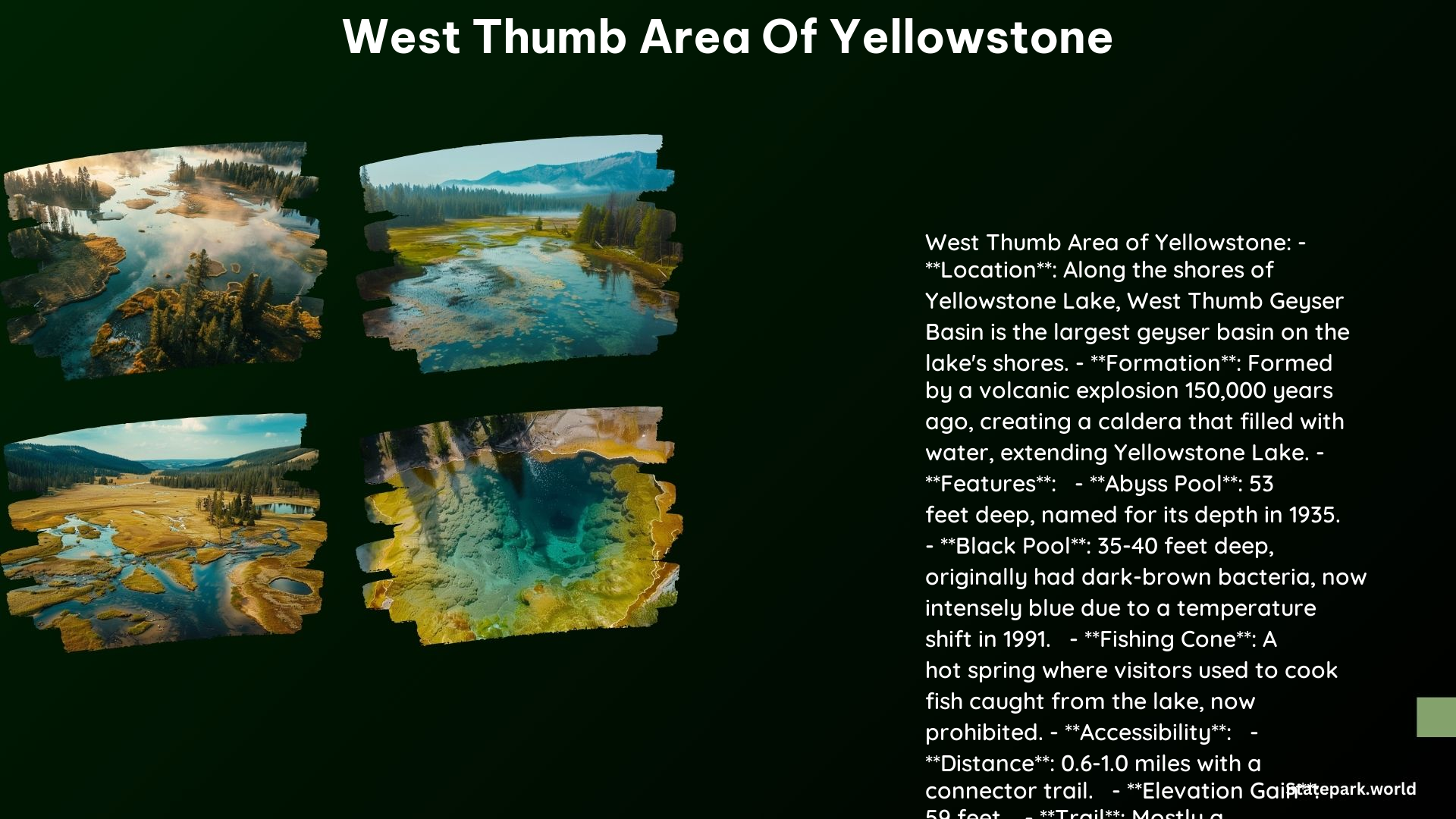The West Thumb Area of Yellowstone National Park is a captivating destination that offers a unique blend of natural beauty, thermal features, and cultural history. Nestled along the shores of the stunning Yellowstone Lake, this region invites visitors to immerse themselves in the park’s geological wonders and uncover the stories that have shaped its past.
Notable Thermal Features in the West Thumb Geyser Basin
The West Thumb Geyser Basin is home to a remarkable collection of thermal features, each with its own distinct character and history.
-
Abyss Pool: Renowned for its depth and vibrant colors, the Abyss Pool is a must-see attraction. Measuring approximately 53 feet deep, this pool was named by Chief Park Naturalist C.M. Bauer in 1935.
-
Black Pool: Once known for its dark color due to the presence of cyanobacteria, the Black Pool underwent a dramatic transformation in 1991 when a temperature shift caused it to take on a stunning blue hue.
-
Fishing Cone: This hot spring is famous for its symmetrical cone shape and its historical use as a spot to cook fish caught from Yellowstone Lake. While the practice is now prohibited, the Fishing Cone remains a captivating feature of the West Thumb area.
-
Occasional Geyser: Located about half a mile north of the main features, the Occasional Geyser erupts periodically, reaching heights of 3-12 feet.
-
Twin Geysers: Nicknamed Maggie and Jiggs, these two vents have periods of dormancy but can erupt to impressive heights of up to 120 feet.
Cultural History of the West Thumb Area

The West Thumb area holds a rich cultural history, offering visitors a glimpse into the past.
-
Native American Hearth Sites: The shoreline of West Thumb is home to several Native American hearth sites, indicating that the area was once used by indigenous peoples.
-
Early Exploration: The West Thumb area was the first Yellowstone feature to be written about in a publication, with Daniel T. Potts describing it in a letter in 1827.
-
Historical Development: The area used to have a large campground, cabins, and other facilities, but these were removed in the 1980s to preserve the scenic quality and protect the natural resources.
Visiting the West Thumb Area
Exploring the West Thumb area is a rewarding experience for visitors to Yellowstone National Park.
-
Accessibility: The West Thumb Geyser Basin is easily accessible via a boardwalk that winds around the basin, making it a convenient and enjoyable destination for visitors.
-
Facilities: The area features a Yellowstone Association bookstore, providing a charming spot to learn more about the park’s history and geology.
-
Timing and Hours: The West Thumb area is open year-round, but the boardwalk and facilities may have limited hours or be closed during the winter months. It’s best to check with park authorities for the most up-to-date information.
Quantifiable Details
-
Cost: There is no specific entrance fee for the West Thumb area, but visitors must pay the general Yellowstone National Park entrance fee of $35 per vehicle for a 7-day pass.
-
Timings: The West Thumb area is open from dawn to dusk, but hours may vary depending on the season and weather conditions.
-
Directory: The West Thumb Geyser Basin is located along the shores of Yellowstone Lake, near the Grant Village area.
-
Hours: The area is open year-round, but facilities may have limited hours during the winter months.
-
Rates: There are no specific rates for visiting the West Thumb area, but the general park entrance fee applies.
-
Value: The West Thumb area offers a unique and valuable experience for visitors, blending natural beauty, thermal features, and cultural history.
Real-Life Incidents and Statistics
-
Fishing Cone Eruptions: In 1919, the Fishing Cone erupted frequently to heights of 40 feet, and in 1939, it erupted to lesser heights.
-
Fisherman’s Accident: In 1921, a fisherman was badly burned at the Fishing Cone, highlighting the dangers of the area and the importance of caution when exploring the thermal features.
